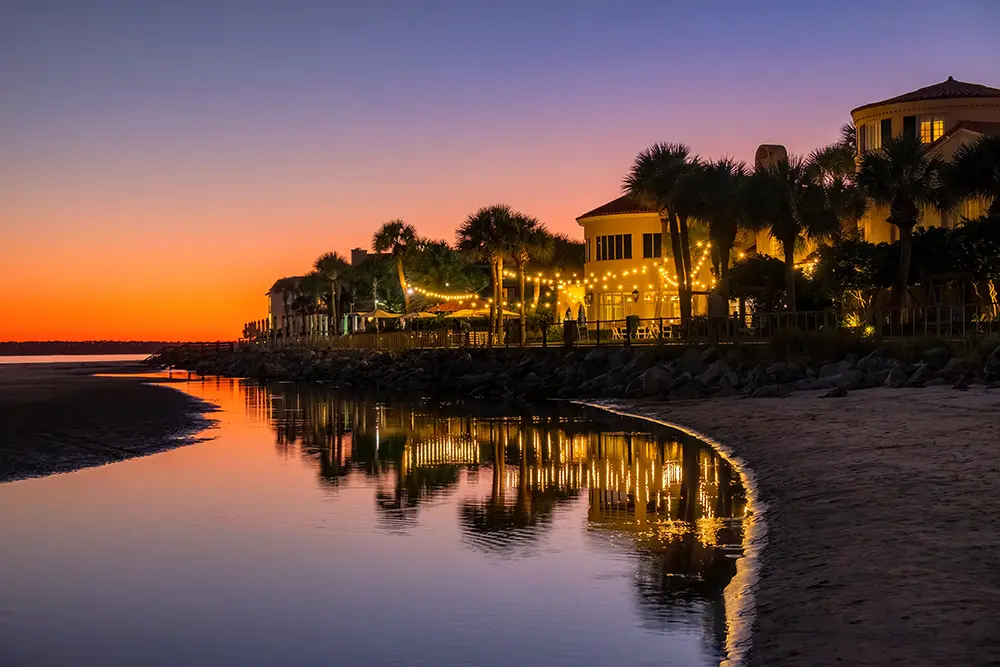St. Simons Island, Georgia’s Diverse History
Ever wondered about the tales hidden in Georgia’s sandy shores? Let me take you on a journey through time, unraveling the history of St. Simons Island Georgia. Picture this: ancient shell rings whispering stories of native American tribes, Spanish missions carving their influence into the landscape…
Now imagine standing tall at Fort Frederica, founded by General James Edward Oglethorpe himself. Can you feel the whispers of strategic plans and secret alliances with Guale Indians echoing off its sturdy walls? As you explore the history of St. Simons Island Georgia.
Inhale deeply as we tread through cotton plantations once thriving under slave labor’s heavy hand; pivotal landmarks during America’s Revolution and Civil War that forever shaped our nation.
A peek ahead reveals how this historic island morphed into today’s coveted resort community…but wait! Take a pause before we move on to our next destination; an area that has transformed from the days of cotton-picking and conflict to a modern resort haven.
St Simons Island is a Special Place
I had the blessed and grateful privilege to work with the team at the King and Prince Resort for a couple of years. I spent enough time on the island including holidays, festivals and Fam-Trips to fall in love with it. Nothing like a sunrise walk on the beach on an Easter Sunday.
If you have the time to plan a trip I can’t recommend it enough. Even if heading south on I-95 get off and cross the causeway to a new experience. Spend an hour a day or more. I will be writing more about our experiences on the island. Thought I would start with a brief history.

Table Of Contents:
- St Simons Island is a Special Place
- Early History of St. Simons Island Georgia
- The Founding of Fort Frederica
- Establishment of Fort Frederica and British Influence
- The Plantation Era and Sea Island Cotton Industry
- St Simons Island during the American Revolution
- St Simons Island in the Civil War
- Transition to a Resort Community
- Historic Landmarks and Sites on St. Simons Island
- FAQs in Relation to History of St. Simons Island Georgia
- In Conclusion History of St. Simons Island Georgia
Early History of St. Simons Island Georgia
The story of Simons Island dates back thousands of years, long before the arrival of European settlers.
Native American Presence and Shell Rings
Inhabited by Native Americans for centuries, this island on the Georgia coast has been shaped significantly by its early inhabitants. The Guale Indians established a permanent village here during the Late Archaic period (around 2500 BCE), as revealed through archaeological findings.
These native people left behind mounds or ‘shell rings’, essentially heaps made up from shells, bones, pottery fragments, and other waste products that provide us with insight into their lifestyle and diet. A key example is found at Cannon’s Point Preserve where middens dating back to 2500 BCE are preserved today.
Spanish Missions and Influence
The Spanish were among the first Europeans to set foot on these barrier islands around 1568 under missions from Santo Domingo aiming to spread Catholicism amongst indigenous tribes.
Saint Simon’s was christened ‘San Buenaventura’ in honor of Saint Bonaventure after they established Mission Santa Catalina de Guale here – an attempt to assert Spanish influence over English threats looming from nearby South Carolina.
This battle between Spain and England over control laid down roots for conflicts later known as “the war of Jenkins’ ear” that led eventually towards establishment Fort Frederica National Monument, a historic site we’ll explore more about later.
So let’s take a step back in time: picture lush forests echoing with bird calls; salt marshes brimming with oysters, clams, and fish; fertile land cultivated by native tribes using rudimentary tools. This was the Simons Island that greeted early explorers.
While these Spanish missions were ultimately short-lived due to disease outbreaks and English incursions, they marked an important phase in the history of Simons Island – a tale steeped in struggle for power, faith conversion efforts amidst indigenous communities while also reflecting survival tales from an era long past.
The Founding of Fort Frederica
Back in 1736, there was a British General who played a pivotal role.
Establishment of Fort Frederica and British Influence
The history of Simons Island is marked by periods of conflict, conquest, and colonization. But perhaps one chapter stands out: the establishment of Fort Frederica.
Founding of Fort Frederica
In 1736, General James Edward Oglethorpe established a fort on Simons Island as part of his broader plan to create a military outpost against Spanish Florida.
This fortress was christened “Frederica” after Frederick Louis, Prince of Wales. The creation signaled the start not only for a permanent settlement but also for an era defined by British influence.
Oglethorpe’s strategy aimed at defending Britain’s territorial claims in North America from any potential threats posed by Spain – its primary rival during this period.
Relations with Guale Indians
Upon arriving at what would become Georgia’s barrier islands, the settlers encountered local indigenous groups such as the Guale Indians who had been living there since time immemorial.
The newcomers’ interactions with these native inhabitants were complex and multifaceted. Some accounts indicate cooperation between colonists and natives; others hint towards conflict and tension. For instance, it seems that while some Gualenians worked alongside Brits constructing forts or tilling fields; many others resented their intrusion into ancestral lands – leading occasionally to skirmishes or outright battles.
Sponsored by:
| Name: | Ft.Frederica National Monument |
| Purpose: | To protect archeological remnants |
| National Park Service |
Today, Fort Frederica National Monument stands as a testament to this past. The site protects the archeological remnants of Oglethorpe’s colony and its struggle against Spanish encroachment.
The Fort at War: Battle of Bloody Marsh
as the War of Jenkins’ Ear. This conflict, marked by its intense battles and political maneuverings, became a defining moment in history.
The Plantation Era and Sea Island Cotton Industry
St Simons Island, the second-largest of Georgia’s barrier islands, underwent a major transformation during the plantation era. This period saw an economic shift from farming to cotton plantations.
Rise of Cotton Plantations
In the early 1800s, Simons became home to large cotton plantations that were powered by slave labor. The island’s fertile soil made it ideal for growing long-staple Sea Island cotton – known for its silky texture and high value in global markets.
This boom was due largely to Eli Whitney’s invention of the cotton gin in 1794, which made processing easier and faster than ever before. Wealthy mainlanders saw this as an opportunity for immense profit and began establishing expansive estates on St Simons.
Among these wealthy settlers were Thomas Butler King who established Retreat Plantation; Pierce Butler who owned Hampton Point Plantation; James Hamilton Couper who managed Hopeton Plantation near Brunswick; John Couper at Cannon’s Point; Anna Page King at Waverly Estate among others.
These estates weren’t just fields of crops – they housed schools, churches, mills — essentially forming self-sufficient communities under their respective owners’ control.
Cotton production thrived until factors like civil war disruption, boll weevil infestation around 1920s hit hard causing a steady decline leading into eventual extinction. This forced landowners to sell off or abandon their properties with some being transformed into resorts while others fell back into nature creating room for later day historic preservation efforts.
The Role of Slave Labor
A critical but grim aspect about this prosperity involved use slave labor force. At peak operation most plantations held between 150 and 500 slaves who were subjected to harsh living conditions.
They worked tirelessly, performing various tasks from tending the fields to working in the homes of plantation owners. The wealth generated by these plantations came at a great human cost that is often overlooked.
Post-Civil War, slavery was abolished. This marked the end of the plantation era because it took away the labor force needed for such large-scale operations. Suddenly, vast tracts were left unattended.
St Simons Island during the American Revolution
The story of St Simons Island is tightly woven into the fabric of America’s fight for independence from British control, and Fort Frederica played a pivotal role in this chapter.
American colonies were on fire with revolutionary fervor by 1775, leading to war against Britain. The colony at Simons was not exempted from these turbulent times.
Fort Frederica, established by General James Edward Oglethorpe years earlier as a defense outpost against Spanish Florida, now found itself central to keeping Georgia loyal to the British throne during this uprising period.
Battlefield or Diplomatic Table?
In many ways, though some skirmishes did occur near Bloody Marsh, much of what transpired on Simons Island involved diplomatic wrangling rather than outright battlefields scenes typical of other regions like Massachusetts or Virginia.
Sidney Breese’s account notes that rather than becoming an arena for battles between redcoats and rebels (like Boston), it became more like an administrative hub where local colonial leaders tried their best negotiating tactics – both carrots and sticks – with royal authorities stationed there under Governor Wright in Savannah just across Altamaha River southward.
Forts And Fires: The Siege Of Fort Howe
Despite being off-the-radar when compared to sites such as Lexington or Concord up north which witnessed bloody conflicts firsthand early-on during those tense days before July 4th declaration got signed over Philadelphia way out westwards beyond Appalachians’ foothills towards Atlantic Seaboard along coastline stretching down towards Florida’s panhandle at Gulf Coast junction where Spanish colonial territories began their boundary marking demarcation line separating them off from British-held lands surrounding Simons & Jekyll Islands plus Cumberland further offshore lying amidst sea lanes used by ships carrying troops or supplies back and forth across oceanic distances between old world Europe continents vs new found Americas discovered centuries ago.
Still, this place didn’t always stay totally peaceful.
St Simons Island in the Civil War
The tranquil sea breezes of Simons Island belie a tumultuous past, particularly during the American Civil War. The island was not immune to the strife and struggle that engulfed the nation.
In this era, Union forces saw strategic value in controlling Georgia’s barrier islands along its coastline including Simons. This allowed them to block Confederate ports and control crucial southern shipping routes.
Union Occupation of St Simons
Early into the war, around 1861, Union troops swiftly occupied Simons Island with little resistance from local Confederate sympathizers who had already fled inland fearing invasion. The National Park Service recounts these events vividly. Under union occupation, plantations were abandoned leading to significant economic impact on an island economy reliant on cotton cultivation.
A remarkable side story unfolded as escaped slaves sought refuge on Union-occupied territory under what was known as ‘contraband’ policy which forbade returning fugitive slaves back into bondage if they reached Union lines or controlled areas like here at Simons.
The Birth of Freedmen Communities
This influx led to the establishment of freedmen communities such as Pier Village, where former slaves lived and worked under relative freedom for the duration of the war years.
“This history,” says Dr. Craig Sheldon, a renowned historian specializing in Southern History, “is often overlooked but it paints a rich tapestry adding more depth understanding how lives were transformed amidst chaos.”
These communities provided valuable services to the Union cause as laborers, scouts, and enlisted soldiers. Some of these individuals even served in the famed African-American regiment known as the 54th Massachusetts Infantry.
Post-War Simons Island
The end of the war did not bring immediate prosperity back to Simons.
Transition to a Resort Community
The transformation of Simons Island into a resort community in the twentieth century was no small feat. Its lush natural beauty, captivating history, and southern charm have long drawn visitors from far and wide.
The island’s allure isn’t just about its size—approximately twelve miles long and nearly three miles wide at its widest stretch—but also its rich tapestry of stories that reach back centuries. As you wander along the sandy shores or through maritime forests, it’s hard not to feel a sense of awe for this Georgia gem.
A New Chapter Begins
In the early 1900s, changes were brewing on Simons Island as industrialization swept across America. However, instead of factories springing up here, wealthy families began constructing grand summer homes alongside rustic fishermen’s cottages.
As word spread about this charming coastal retreat with its gentle sea breezes and majestic live oaks draped in Spanish moss, more people started flocking here seeking relaxation and adventure alike.
The Birthplace of Southern Hospitality
No tale about Simons’ transition into becoming a resort community would be complete without mentioning The King & Prince Hotel. Opened originally as a dance club in 1935 during the height of The Great Depression – an act both bold and provocative -, it quickly became an iconic symbol representing luxury amidst hardship.
This stunning hotel by the ocean embodied what would become known worldwide as ‘Southern hospitality’, drawing celebrities like American President Jimmy Carter who savored their famous Brunswick stew while gazing out over vast Atlantic Ocean vistas.
Beyond Tourism: Preserving Heritage
Yet even amid these transformations into being one among premier holiday destinations on Georgia Coast, there remained a deep commitment to preserving the island’s unique history and culture. The locals understood that their heritage was an integral part of the charm that drew people in.
This dedication is reflected in sites like Fort Frederica National Monument, which safeguards remnants of the local British colony, or Christ Church, Frederica—one of Georgia’s oldest churches—that still holds services today.
The Modern Resort Community
Today’s the day. Let’s make it count.
Historic Landmarks and Sites on St. Simons Island
St Simons Island, one of Georgia’s barrier islands, is rich with history that dates back thousands of years. From its early beginnings to the present day, it has been home to a myriad of cultures and societies.
The island stretches approximately twelve miles long and nearly three miles wide at its widest stretch. It houses some remarkable historic landmarks worth exploring when you visit this charming sea island.
Christ Church Frederica
Christ Church Frederica, located in Glynn County, stands as one of the oldest churches in Georgia – a testament to St. Simons Island’s deep-rooted Christian faith.
This church was originally established by Charles Wesley but saw reconstruction efforts led by Frederick Louis after it was destroyed during the Civil War. The building now serves as an embodiment of resilience through trying times – holding centuries’ worth stories within its hallowed walls.
Besides being an active place for worship today, Christ Church Frederica also hosts events throughout the year celebrating local traditions and community spirit—drawing visitors from all around.
Fredrica National Monument
If we journey further into history along the meandering Frederica River we find ourselves standing before Fort Fredrica National Monument—a spot where American colonial history takes center stage.
In response to Spanish threats from Florida in 1736 General James Edward Oglethorpe founded this fort making it integral part defending British colonies against Spain during War Jenkins’ Ear (National Park Service source).
The fort later played key role revolutionary battles too; however today remains silent witness past offering glimpses times gone by. You can explore archeological remnants British colony defense against Spain preserved here at Fort Frederica National Monument.
Gascoigne Bluff and Hamilton Plantation
The story of St. Simons Island’s plantation era comes alive when you visit Gascoigne Bluff, the site where Sea Island Cotton was once cultivated extensively.
must never forget. The Hamilton Plantation witnessed its peak during this era, with enslaved labor being a critical part of the operations. This period marks a grim episode in the island’s history that we should always remember.
FAQs in Relation to History of St. Simons Island Georgia
What is the history of Saint Simons Island?
History of St. Simons Island Georgia spans from Native American habitation and Spanish colonization to British influence, Civil War involvement, and its modern role as a resort community.
How many plantations were on St. Simons Island?
The exact number varies but during the Plantation Era, several large cotton plantations thrived on Simons due to fertile soil and slave labor.
What are some fun facts about St. Simons Island?
This island is Georgia’s second-largest barrier island. It has archaeological sites dating back to 2500 BCE and it transformed into a popular resort in the twentieth century.
What is the ethnicity of St. Simons Island?
A majority of residents on Simons are Caucasian according to recent U.S Census data; however, there’s also African-American presence reflecting rich cultural diversity.
In Conclusion History of St. Simons Island Georgia
Simons Island, Georgia’s history is as layered and rich as the soil of its cotton plantations. You’ve traveled from ancient Native American settlements to Spanish colonial influence.
You’ve stood with General James Edward Oglethorpe at Fort Frederica, hearing whispers of alliances with Guale Indians. You felt the weighty past of slave labor in plantation fields.
You bore witness to Simons’ role during America’s Revolution and Civil War periods that forever changed our nation. And you’ve seen how this storied land transformed into a coveted resort community.
The footprints left behind on these barrier islands tell us stories of survival, change, resilience and evolution over centuries… A testament to humanity’s unyielding spirit amidst changing times.
From sea shell rings to Christ Church Frederica’s towering steeple – each holds a chapter in the fascinating history of Simons Island Georgia…
A story worth remembering!






